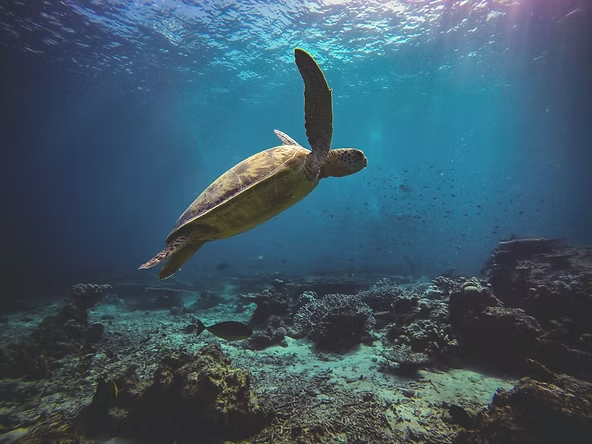Green Turtle: The Ocean’s Herbivorous Giant
The green turtle is the largest species of hard-shelled sea turtles and second only to the leatherback in overall size. Unlike its name suggests, the shell or skin of this turtle is not distinctly green. Instead, its name comes from the greenish color of the fat beneath its shell. This unique feature is linked to its strict herbivorous diet, as the green turtle is the only sea turtle that feeds exclusively on seagrasses and algae.
Incredible Migration Journeys
Green turtles are known for their remarkable long-distance migrations, sometimes crossing entire ocean basins between feeding grounds and nesting beaches. They rely on the earth’s magnetic field as a natural compass to navigate these journeys. Like other sea turtles, female green turtles return to the exact beach where they hatched to lay their own eggs, a behavior known as natal homing. The two most important nesting areas for green turtles today are the Caribbean coast of Central America and Australia’s Great Barrier Reef.
Nesting and Early Life
When nesting, females dig nests on sandy beaches and deposit about 100 eggs per clutch. Over several weeks, they may nest multiple times. Once hatched, the tiny turtles scramble to the sea and swim offshore to begin their early years of life in open waters. After growing to a certain size, juveniles move into nearshore habitats rich in seagrass and algae, transitioning fully to a plant-based diet. Adults typically remain in coastal areas, particularly seagrass meadows, which serve as both shelter and a vital food source.
Unusual Behavior in Hawaii
Although sea turtles usually come to shore only for nesting, one unique population in Maui, Hawaii, displays a different behavior. Some individuals are known to haul out onto beaches during the day to bask in the sun. This behavior is rarely observed elsewhere and highlights the adaptability of green turtles in certain environments.
Major Threats to Survival
Despite their resilience, green turtles face numerous human-related threats that have pushed populations to dangerously low levels. These include:
- Habitat loss: Degradation of nesting beaches and foraging grounds due to coastal development and climate change.
- Direct exploitation: Harvesting of turtles for meat and eggs in some regions.
- Bycatch: Accidental capture in fishing gear such as trawls, nets, and longlines.
- Vessel strikes: Injuries and deaths caused by collisions with boats.
- Marine debris: Entanglement in discarded fishing gear or ingestion of plastics.
Conservation Efforts
Many countries now provide legal protection for green turtles, prohibiting hunting and egg collection. International agreements such as CITES also regulate trade in turtle products. However, enforcement remains inconsistent, and illegal harvesting continues in some regions. Conservationists emphasize the importance of protecting nesting beaches, reducing bycatch through improved fishing practices, and maintaining healthy seagrass ecosystems. Without sustained global efforts, green turtles may continue to decline, but with proper protections, their populations can recover and thrive once again.

